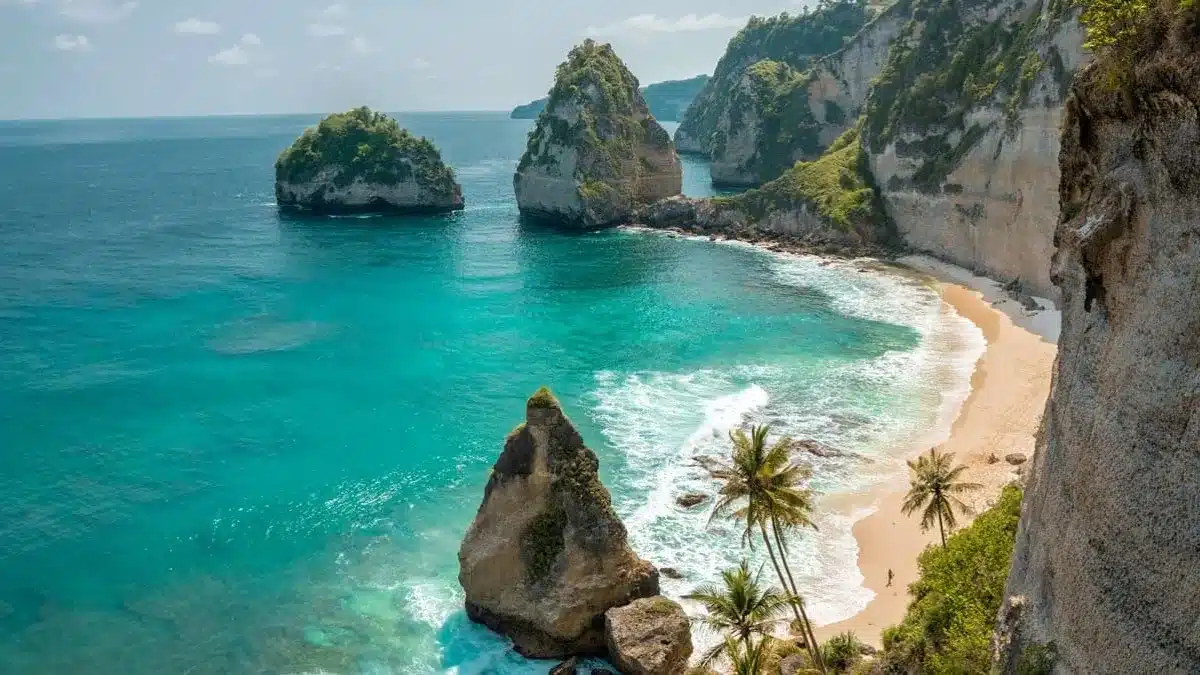Klungkung Regency is Bali, Indonesia’s smallest regency (kabupaten). It has a land area of 315 km2 and a population of 206,925, according to the 2020 Census.
Semarapura serves as the regency’s administrative centre (as well as the administrative centre for Klungkung District within the regency).
The offshore islands of Nusa Penida, Nusa Ceningan, Nusa Lembongan, and eleven smaller islands combine to form the Nusa Penida District, the administrative centre of which is the town of Sampalan; the other three districts are located on the island of Bali itself, in the south-east portion.

Points of Interest
- Klungkung Regency Capital: This lively market town on the primary route between Besakih and Amlapura is steeped in history. It features some notable sites, including the Semara Pura Palace complex, the Hall of Justice and the Kambang Pavilion. The market here sells fascinating textiles weaved in Bali’s eastern region and sea salt panned from local beaches.
- Taman Gili Palace: Built by royal court artisans during the Dewa Agung dynasty. Apart from the main gate and two buildings that were rebuilt and renovated in the 1940s, little remains of this palace were devastated during the Dutch invasion of Bali.
- Kertha Gosa (Judgment Hall): A Hall of Justice that served as the kingdom’s supreme seat of arbitration. The ceiling friezes represent horror and retribution scenes. Villains convicted here were imprisoned on the island of Nusa Penida.
- Bale Kambang: Next to the Judgment Hall, this floating pavilion’s ceiling friezes represent images from Buddhist folklore and astrology.
- Bat Cave (Goa Lawah): A cave claimed to hold the frightened snake that defends the holy Mount Agung and the universe. This bat-infested cave features numerous passageways, some up to 30 kilometres long, one of which is supposed to lead to the Temple of Besakih.
- Gelgel: In the fourteenth century, the royal household was headquartered in the village of Gelgel. The Jero Agung and Dasar temples are worth seeing, with the latter reserved for ceremonies of Bali’s higher castes or aristocracy.
- Kamasan: A small village near Klungkung that gave birth to the Kamasan style of Balinese painting based on east Javanese shadow puppets or wayang.
- Kusamba: A salt-panning town with a black sand beach.
- Nusa Penida: The largest of the three offshore islands, covering over 200 square kilometres. White sand beaches and white cliffs demonstrate that this island is not volcanic but composed primarily of limestone. Nusa Penida was historically a penal colony for the Klungkung Regency; undesirables were brought here after being condemned in the Kerta Gosa. A very arid climate and a local myth of a violent giant, which gives Penida a bad image, keep the population at around 45’000. Penidan families make their living mostly through fishing and farming, with seaweed being the island’s most important export. Samplan, on the island’s northeast coast, is the principal town; this, along with 18 hamlets, constitutes the whole of Penida’s residential area. Peed and Batukuning temples are worth a visit. Unfortunately, due to strong currents, Penida’s dive sites are difficult to access.
- Nusa Lembongan: A small low-lying island about 2.5 kilometres wide and 4 kilometres long. This island offers white sand beaches, crystal clear oceans, and coral reefs, and it is quickly becoming a popular tourist destination. Diving, snorkelling, glass bottom boat rides, and other tourist activities are popular on this island, which cruise ships visit. Seaweed farming is the principal cottage industry here, and the seaweed gardens are definitely worth visiting at low tide. An underground house scooped out of the ground with a spoon is a unique spot to visit on the island! Additional activities include walking around the traditional village and taking a small boat tour of the mangroves. Surfers flock to Jungut Batu on the island’s northeast.
- Nusa Ceningan: The smallest of the three islands, consisting primarily of a sand flat. The term derives from the Balinese word for little, cenik. The small islet is rarely visited and is home to a bat cave, fantastic coral, and marine life.
- Penida Island: Formerly the Klungkung kingdom’s correctional island. The Dalem Peed Temple is linked to mythology and dark magic.
Districts of Klunkung Regency
| Name | Area in km2 | Pop’n Census 2020 | No. of villages | Post codes |
|---|---|---|---|---|
| Nusa Penida | 202.84 | 57,370 | 16 | 80771 |
| Banjarangkan | 45.73 | 44,431 | 13 | 80752 |
| Klungkung | 29.05 | 64,235 | 18 | 80711 -80716 |
| Dawan | 37.38 | 40,889 | 12 | 80761 |
| Totals | 315.00 | 206,925 | 59 |
The Klungkung Palace
The infamous Klungkung Palace is a historical site in Semarapura (Klungkung), the capital of Bali’s Klungkung regency (kabupaten).
The palace (puri) was built at the end of the 17th century but was severely damaged in 1908. The palace’s notable ruins have become part of the Court of Justice, the main entrance, and the Kertha Gosa Pavilion, which carries the date Saka 1622. (AD 1700).
A floating pavilion, Bale Kambang, was constructed in the original palace compound in the 1940s.
The descendants of the rajas who previously governed Klungkung reside in Puri Agung, a mansion erected after 1929 to the west of the original palace.
From the late 17th century through 1908, the Klungkung kingdom was regarded as the highest and most powerful of Bali’s nine kingdoms.
It was the heir of the old Gelgel monarchy, which had long ruled the island but had disintegrated in the late 17th century.
Dewa Agung Jambe I, a prince descended from the previous Rajas of Gelgel, migrated to Klungkung (also known as Semarapura) in 1686 (or, in another version, 1710), erecting a new palace or puri.
While not having the prerogatives of his Gelgel forefathers, the new palace maintained grandeur and precedent on the politically divided island.

